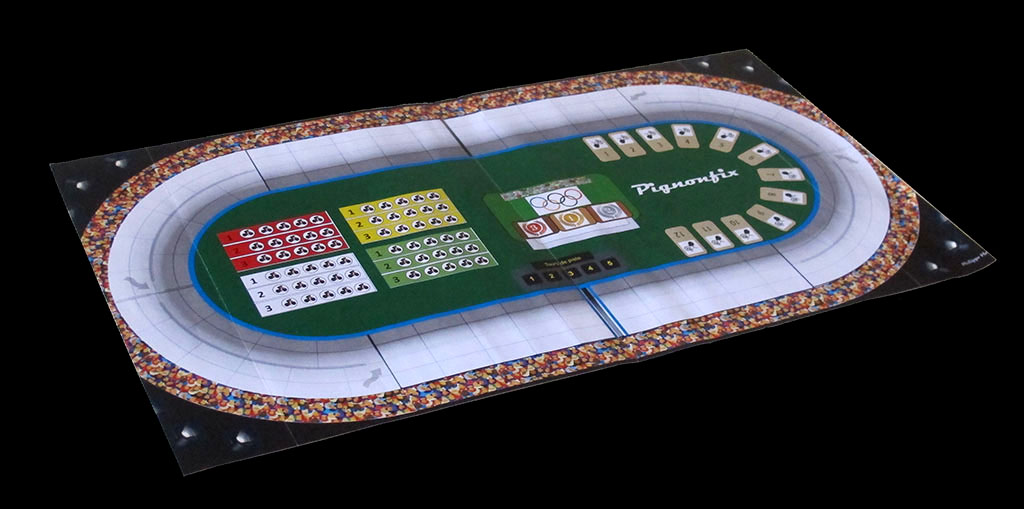
PIGNONFIX
Philippe Heully, France, 2024

Track cycling games can be broadly divided into two categories: games that represent just one event, that is, games with mechanics that are adapted to the specificities of only one race format, and general games, the mechanics of which are loose enough to be able to represent almost any type of track cycling race. (There is actually a third category: track cycling games that are in-between, but we will leave those apart).
To the first category belong games such as Teamsprint, Match Sprint, Keirin, a few of the Correo dei Piccoli games and, to some extent, Devil Takes The Hindmost (my reservations on the latter arise from the fact that its otherwise brilliant mechanics could be easily adapted to most race formats). We might also include in this category games specifically dedicated to six-day races, but these are a different family (not to be confused with games titled "six day race", which are much more common).In the second category, we find games that offer rules for playing various track cycling events. There are quite a few games in this category: Jeu du Veldiv (the classic of classics), 6 in einem (the name tells it all), Zes Dagen Spel (despite its name), and many others, including, of course, Pistard. There is no shortage of such games, and though a few of them are quite good indeed (I will not spoil the pleasure of finding out which by yourselves), they have a built-in weakness, which is that it is very difficult (to say the least) to have game mechanics that suit equally well all the tracking events. In the same manner that not all cyclists are equally adapted to all events, the same can be said of game mechanics. What do events like, say, a team poursuit and a points race have in common? These multi-purpose games are necessarily bound to have general rules that are not the best possible game for each event but rules that will work for all events. That is why I tend to prefer games in the first category mentioned above.
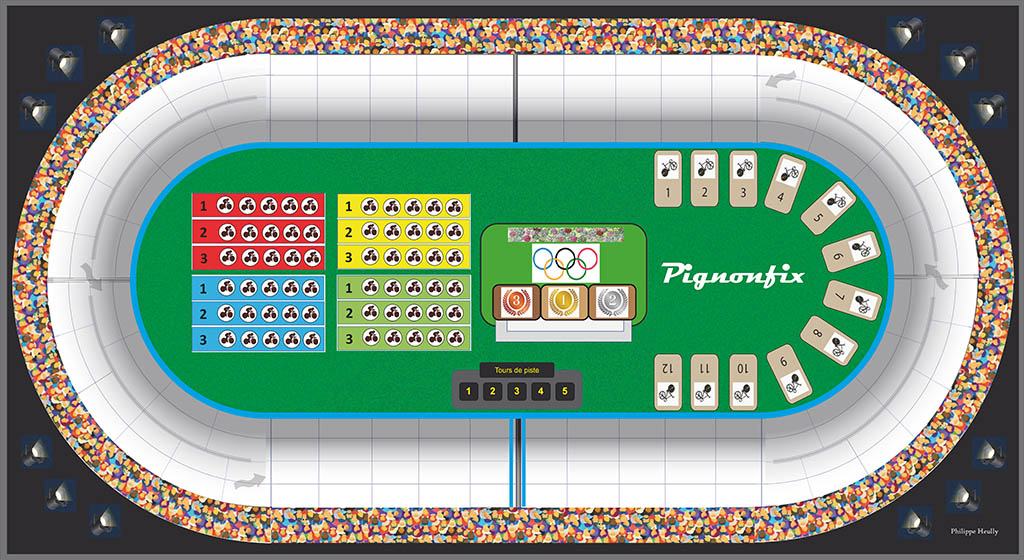
This said, I am proud to offer a new multi-purpose track cycling game as a free download (scroll down to find the links) for you all. Pignonfix (what a great name for a track cycling game!) has been created by Philippe Heully, from Paris, who suggested that the game be offered in time for the Paris 2024 Olympics. I immediately thought it was a fantastic idea. However, even though the game was mostly finished, some details have been changed as game testing progressed, and having such an unpostponable deadline meant that these changes had to be limited in time.
On the other hand, since this game was meant for the Paris Olympics, it has rules for ALL the track cycling events, which is probably a world record (or at least a record in my collection). There are rules for ELEVEN different track cycling races, including all four different Omnium events. I do not think I have another game with rules for so many events, and I readily admit that I have not had time to play them all yet. So, in a sense, and I think Philippe will agree on this, this game is a work in progress. Feel free to tell us what you think, make suggestions, request rules' clarifications, or even invent additional rules.
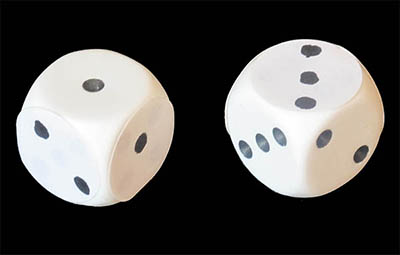
Modified dice
PIGNONFIX is a dice game, but one that does not use regular dice, but a pair of modified D6 instead, with values 112233. I admit I am responsible for not offering a model of these dice for download. I talked him off doing it since cut-up cardboard dice suck. Therefore, you will have to customize a pair of dice with stickers and a marking pen, or just use two regular dice and remember that 4=1, 5=2, and 6=3. (Spoiler: I did it, and then decided it was better to use stickers).
You can probably do it better than me, at least judging from the picture above. I can also do it better, but then you would not have noticed the modification in the picture.Players throw both dice, but they can choose to use the result of just one of them. There are a couple of good reasons for not wanting to speed, the most obvious of which is to avoid crashes. As the name of the game suggests ("pignon fixe" means "fixed gear"), track cycling bikes do not have brakes, and since cyclists in this game cannot pass through occupied squares, excess speed can cause falls in case other riders block the road. This is an issue in crowded events like scratch races while, of course, will never happen in individual pursuit.
Under certain circumstances, riders can choose not to throw the dice and simply follow the draft of the rider ahead, gaining energy points from it. Riders start the game with some energy points (depending on the event), marked on a special section of the board, and may gain up to five energy points during the race, of which they can spend up to three in a single game turn. These energy points are added to dice throws at strategic moments of the race. So, even if its detractors can always say that "it is only a dice game", and even if of course it is a game that depends on luck, Pignonfix offers a rule for energy management that requires a certain amount of strategic thinking. Naturally, this is more true of some events than of others.Furthermore, the drafting rule works nicely to keep the bunch packed in a quite natural way, which gives the game a nice "cycling feel". Again, of course, this is only true in events where bunch riding applies.

Another distinctive feature of velodrome racing are banked bends. However, many -most, in fact- track cycling games do not have a rule for them, which often turns them into mountainless-cycling-race-on-an-oval-track games. This is not the case with Pignofix. Cyclists can choose to take the curve on the inner lanes or on the outer lanes. Inner lanes are shorter, but outer lanes offer extra dice throws. The outcome is mathematically balanced, but subtle nuances in the race's development may make you prefer one or the other option. Again, not all track disciplines are equally suited to this rule.
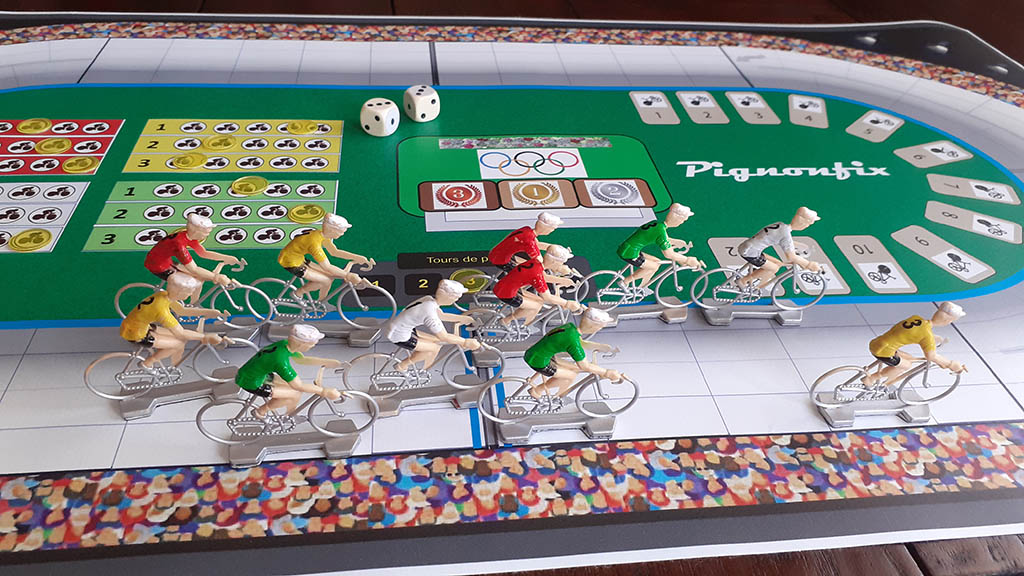
Big board with big plastic riders (photo by Philippe Heully)
Finally, there is one last issue worth mentioning before you (or at least those among you who can either read French or use an automatic translator) immerse yourself in Pignonfix rules. The rule for the end of the race is original, different from other games, and can be confusing the first time you play the game, especially if you start, as I did, with an overcrowded scratch race that ended in a mass sprint.
My advice is:
(a) Start with lighter events, which will allow you to master the subtleties of the game -aspiration, curves, energy management-, before playing the Omnium or Madison events.
(b) Make sure every player understands the finish rule. Do not take it for granted. Read carefully the example provided in the rules.
(c) You can always use a different endgame rule, one of which you feel more comfortable with. It will not really change the game that much. Just make sure you decide whether you use a different rule BEFORE you start the race.You may have guessed that the first time I played the game I made every possible mistake. Most riders ended the race with their energy complete, which only shows that they should have raced faster, and the game had to be interrupted during the last game turn because it was too late to reach an agreement on who had won the race. (The good thing is that most players went home sure that they had won. Disclaimer: the finish line example was not in the rules yet). However, all players found the game good enough to play it again.
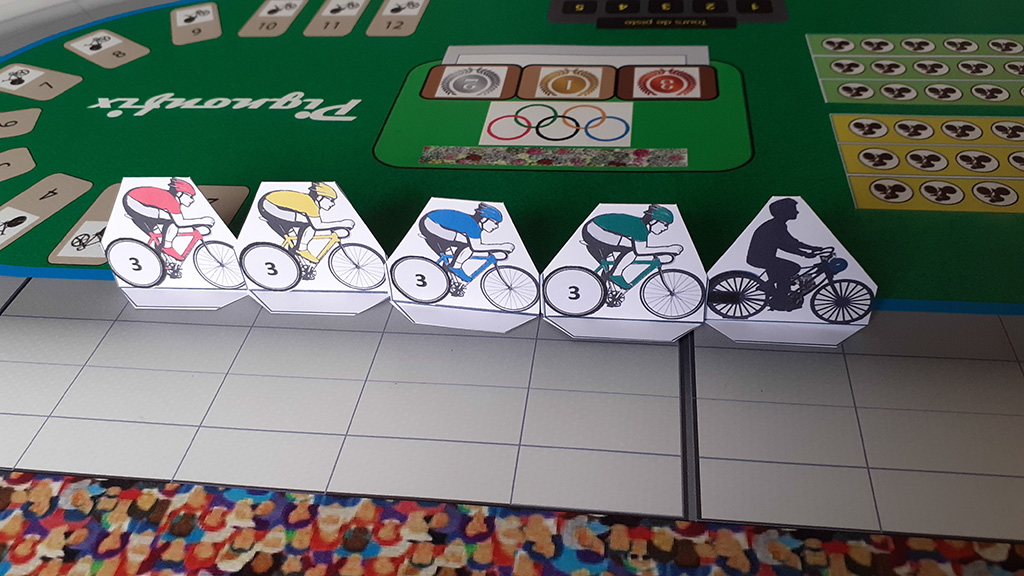
Same big board with 45 mm cut-up riders and the derny (photo by Philippe Heully)
The game was originally devised to be used with big Cofalu plastic riders, as they are easy to find and fairly inexpensive. You may even have some at home. (If you are a good observer, you may have recognized that the ones in the picture above are reused from this recent game). However, nou need a big board to play with big riders, which is not exactly the idea behind print'n'play games, so I suggested that there be two versions of the game, the aforementioned big board and a smaller one, as well as cut-up riders in two sizes. The small version was tailored to be used with the commonly available 3 cm plastic cycling counters, as you can see in the pictures. (Finally, I also suggested making the boards printable in A4 and in A3 printers, though of course you will not need both).

Small board with 25 mm cut-up riders
Except from the fact that I did not cut the (upper) angles before taking the shot, you might have thought that the cyclists featured in the two pictures above were the same. Well, the cyclists with uncut angles are around half the size of the others. The wonders of referencelessness.
If you prefer to experiment with different riders, you will find some more, in different sizes and flavours, in the make your own game section of this site.
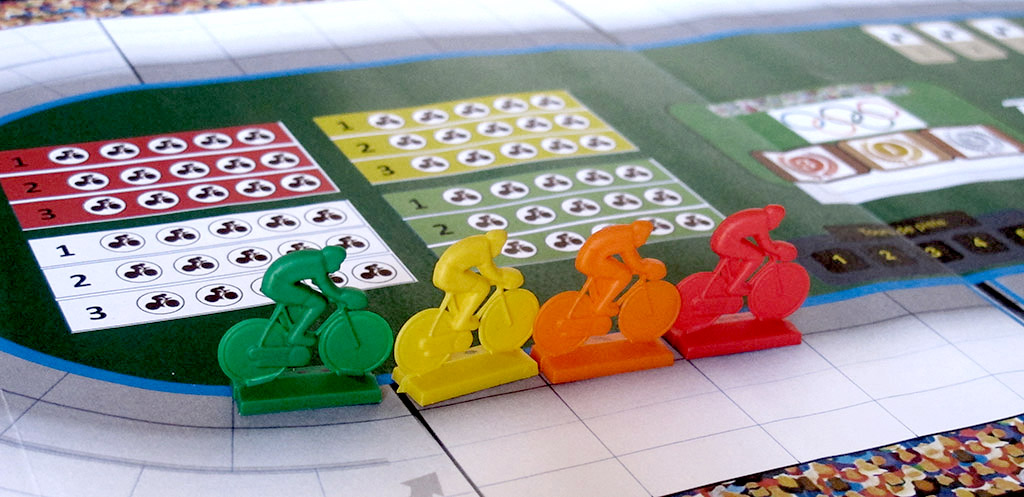
Same small board with 3 cm plastic figurines. Their base measures 25 mm, and that is what counts.
(I am afraid the light was not too good when I took this picture; sorry about that).

Here are the same plastic figurines seen under a different light.
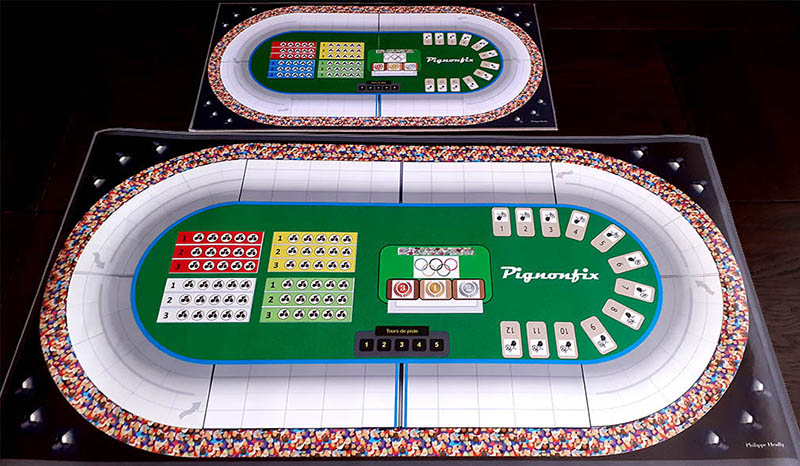
The two boards size by size for comparison (photo by Philippe Heully)
If you have read this far, you should have an idea of what I think of Pignonfix, but let me insist: it is an interesting game, and it can probably profit from further players' feedback. I have not yet tried all the track disciplines myself. I intend to do so during the Olympics. Can you think of a better occasion?
By the way, in most pictures you will see that one of the teams in the energy area is white, while on the downloaded files, or on the small board in the picture above, it is blue. The colour was changed during the game development, and some of the pictures were taken before the change.
As I intend to print the game on a big mat or vinyl for my Olympic plays, expect me to update this description with new pictures. In the meantime, it is your turn to play!
DOWNLOADS
We are very proud to offer this game as a free download in our collection of free print-and-play games.As said above, this game is available in two sizes, and for each size you will find two versions of the board, one for A4 printers and one for A3 printers. Additionally, we provide the board in one single file, in case you want to have it professionally printed. We also offer cut-up cyclists in two sizes, but you can use your own figurines if you have them.
What we do not provide are the special dice. Again, see above why we don't. Finally, you will also need thirteen counters. You can use anything, really, from one cent coins to washers, to shirt buttons, to other game pieces. Since cardboard printed counters are the worst possible option, we do not provide them either.
RULES
You will need the rules, no matter what version of the game you download. So far, they are only in French. An English version may be added later (if you feel like helping, please write). However, I am sure you understand French, or at least know how to use an online translator.
>>> Download the RULES (PDF, 1 MB)
SMALL VERSION OF THE GAME
More than enough to check out the game.
50 cm board, suited to play with 3 cm plastic cyclists or with the 25mm cut-up cyclists provided.
Of course, you need only one of the versions of the boards.>>> Download the 50 cm board ready to print on an A4 printer (PDF, 3 pages, 3 MB)
>>> Download the 50 cm board ready to print on an A3 printer (PDF, 2 pages, 3 MB)
>>> Download the 25 mm cut-up cyclists (PDF, 300 KB)
BIG VERSION OF THE GAME
For a better game experience.
86 cm board, suited to play with Cofalu-sized figurines or with the 45 mm cut-up cyclists provided.
Again, you need only one of the versions of the boards.>>> Download the 86 cm board ready to print on an A4 printer (PDF, 10 pages, 8.5 MB)
>>> Download the 86 cm board ready to print on an A3 printer (PDF, 6 pages, 8.5 MB)
>>> Download the 45 mm cut-up cyclists (PDF, 300 KB)
BOARD FOR PROFESSIONAL PRINTING
This is the one you need if you plan to have the game printed on a mat, cloth, vinyl, etc.
Perfect to play with Cofalu-sized figurines, though you can still use the big cut-up cyclists.>>> Download the big board (86 x 47 cm) in a single file (JPG, 8.5 MB)
Description written in July 2024
 |
 |
 |
 |
 |
|
CULTURE IDEAS |
TOTUM REVOLUTUM THUMBNAILS |
NAMES ALPHABETICAL |
CATEGORIES LISTS |
WHAT'S NEW BLOG |